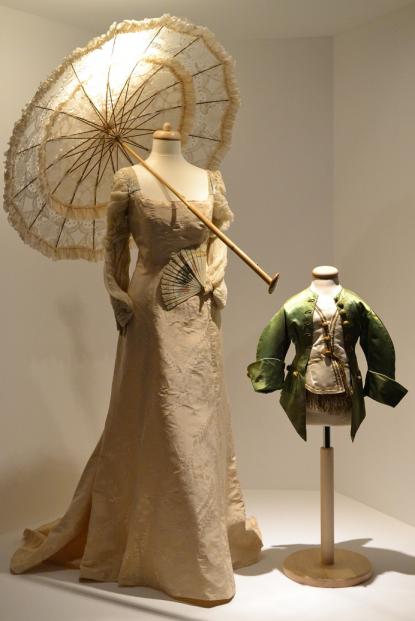2024. May 7. Tuesday
Savaria Museum (Vas County Museums Authority) - Szombathely
 |
Address: 9700, Szombathely Kisfaludy Sándor utca 9.
Phone number: (94) 500-720, (94) 501-948
E-mail: info@savariamuseum.hu
Opening hours: Tue-Sun 10-18
|
The exhibition has closed for visitors.
2015.05.17. - 2015.10.29.
Museum tickets, service costs:
|
Ticket for adults
|
1600 HUF
|
|
|
Ticket for students
|
800 HUF
|
|
|
Group ticket for students
(over 15 people)
|
600 HUF
|
|
|
Ticket for pensioners
|
800 HUF
|
|
|
Ticket for families
(2 adults + min. 2 children)
|
2400 HUF
|
/ family
|
|
Guide
|
5000 HUF
|
|
|
Guide
|
8000 HUF
|
Hearing the word silk, most of us will imagine floss, the flexible weavable fibre gained from moth caterpillar. However, many other organisms also provide a fibrous material, which is an expensive and valued silk fabric: several moth larvae excrete silk. Even the spider thread or the Mediterranean native Pinna nobilis bisus thread can be used to produce fabric. Fabrics made of exotic lotus silk, agave silk or the milkweed crop silks are representatives of the rare plant silk.

In China, the secret of production of silk was kept for 25 centuries; until it finally leaked. The craft of silk making reached Europe in the 5th century and had its golden age in Hungary at the end of the 19th century.
The first part of the exhibition presents animal and plant species that produce silk fibre, as well as former silk-making toolkits.
Fashion, this Mysterious Tyrant
The exhibition deals with a very exciting era, collection or wear type and is trying to illustrate the diversity of silk fabrics made from other kinds of silk, namely silk taft, silk velvet and silk damask. Prominent part of the exhibition are the historical ornamented Hungarian vestments linked to renowned personalities from Vas County and also exotic pieces that were acquire by the aristocratic private collection of Gyula Végh during his journeys to the orient. From the end of the 19th century and the first half of the 20th century female costumes guide the visitors to another dimension. The women's costumes presented here only provide an introduction to the cavalcade of shapes, colors and materials. The 1920s female fashion undergone significant changes, as shown in the costumes on display - silk blouses, casual suits camisole-scale Charleston dresses. After the First World War, a new lifestyle emerged. Women were liberated, a new beauty ideal surfaced, the garçonne, the individual combining boyish and girlish attitude: an individual self.
In the purple boudoir
The exhibition selecting from the Smidt Museum material provides insight into the homes of the dualism period, namely into the most personal spaces.
The boudoir, the women's locker room in France in the 18th century, appeared at the royal court and aristocracy, in the spirit of the Rococo style, but over time it spread among civil society members as well. In accordance with the boudoir's former three functions, we deal with the lounge, dressing room and bathroom. Hygiene habits are to reflect the lifestyle of the era, the most intimate spaces of everyday with the objects.
At the turn of the century, the appreciation of underwear for girls and women's received increased appreciation and evaluation of a woman's locker depended on the lingerie she had. Stockings, corsets, pants, petticoats, bed jackets worn during the daytime and night wear such as sleeping shirts for women invite the visitors to the private world of women, into the most intimate sphere.
The costumes, accessories, works of art, photos, pictures from fashion magazines and advertisements of the era evoke the milieu of civilian homes and female fashion. In addition to day and night garments, silk specialities, and prerequisites for women's beauty products, a cavalier will appear …

In China, the secret of production of silk was kept for 25 centuries; until it finally leaked. The craft of silk making reached Europe in the 5th century and had its golden age in Hungary at the end of the 19th century.
The first part of the exhibition presents animal and plant species that produce silk fibre, as well as former silk-making toolkits.
Fashion, this Mysterious Tyrant
The exhibition deals with a very exciting era, collection or wear type and is trying to illustrate the diversity of silk fabrics made from other kinds of silk, namely silk taft, silk velvet and silk damask. Prominent part of the exhibition are the historical ornamented Hungarian vestments linked to renowned personalities from Vas County and also exotic pieces that were acquire by the aristocratic private collection of Gyula Végh during his journeys to the orient. From the end of the 19th century and the first half of the 20th century female costumes guide the visitors to another dimension. The women's costumes presented here only provide an introduction to the cavalcade of shapes, colors and materials. The 1920s female fashion undergone significant changes, as shown in the costumes on display - silk blouses, casual suits camisole-scale Charleston dresses. After the First World War, a new lifestyle emerged. Women were liberated, a new beauty ideal surfaced, the garçonne, the individual combining boyish and girlish attitude: an individual self.
In the purple boudoir
The exhibition selecting from the Smidt Museum material provides insight into the homes of the dualism period, namely into the most personal spaces.
The boudoir, the women's locker room in France in the 18th century, appeared at the royal court and aristocracy, in the spirit of the Rococo style, but over time it spread among civil society members as well. In accordance with the boudoir's former three functions, we deal with the lounge, dressing room and bathroom. Hygiene habits are to reflect the lifestyle of the era, the most intimate spaces of everyday with the objects.
At the turn of the century, the appreciation of underwear for girls and women's received increased appreciation and evaluation of a woman's locker depended on the lingerie she had. Stockings, corsets, pants, petticoats, bed jackets worn during the daytime and night wear such as sleeping shirts for women invite the visitors to the private world of women, into the most intimate sphere.
The costumes, accessories, works of art, photos, pictures from fashion magazines and advertisements of the era evoke the milieu of civilian homes and female fashion. In addition to day and night garments, silk specialities, and prerequisites for women's beauty products, a cavalier will appear …






